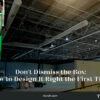JACK MUFFOLETTO, TK Principal, presented at ShowEast 2014 Tradeshow in Hollywood, Florida on October 13, 2014.
The topic of the presentation was: The Movement Toward Recliner Seating and What Considerations Go Into An Auditorium Layout.
Presentation Transcript:



The most obvious question we get asked is “What is the row spacing?”
However, there are key factors in auditorium layout that are not-so-obvious
- Riser height
- Seat base distance from the riser behind it
And, there are key constraints
- Sightlines
- Building code
On sightlines, our goal is an unobstructed view to the bottom of the screen
- The screen needs to be as low as possible for the best screen presentation
- We must provide dual sightlines studies looking at the patron’s point of view from the upright and reclined positions. Often times we will raise the riser height.
Raising the riser height has side effect
- You can create a dangerous gap between the back of the recliner in the upright position and the row above where a patron could be walking.
- We need edge protection and many times we will use a low wall.
We may also need to move the seat away from the riser in order for the seat back to recline.
- This increases the row dimension
- Which increases difficulties with unobstructed sightlines to the bottom of the screen.
The Building Code causes a constraint.
- There are minimum clearance calculations for the row, that increase based on the amount of seats.
- There are further additions to the clearance requirement if it is an accessible row.
To answer the most fundamental Question of row spacing
- Know the exact chair
- Determine the riser height based on sightlines
- Determine how far the seat is offset from the riser face
- Calculate code minimum requirements for clear space
- Add it up and you get the row spacing
To learn more about TK and get your design questions answered, please CONTACT US.



